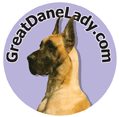 |
GREATDANELADY.COM Linda Arndt ~ Canine Nutritional Consultant Email: |
 |
Front-End Assembly of Great Danes |
|
Quote: She stated in one of her articles that "it can take as many as 5 generations to get your good shoulders back...if ever." This comment came up as part of a lengthy discussion on one of the Great Dane discussion lists. I would like to address this particular comment as one who teaches structure and design, not just as a dog breeder. I think a breeding program can correct a poor front, at least several in a litter, in 1-2 generations, IF you know what you are looking at to begin with, and then select accordingly to correct the problem. The problem with the front end assembly in our breed is that people to not know how to "see" what they are looking at, when it comes to anatomy. They may know the names of the bones and muscles but there is MUCH more to it. Teaching people how to "see" the parts and how the parts "relate" to the whole animal is a very complicated process . I am going to give you an idea of things to consider, when trying to fix a front assembly problem. That way you will understand why it is so hard for most people to fix their fronts, because they are not educated in "seeing" form and proportion and it's relationship to each other. First - it is very difficult to find good examples to show you. Second, in understanding the front end assembly you need to realize Shoulder blade:
So all of those things must be considered when trying to correct a front. Let me clarify something when I say the 3-dimensional form of the bone varies on each dog, and I will give you an example. An Illustration: Upper Arm: Leg from elbow to the wrist (carpal joint) What is the length, width and shape of the bone and what is the length in relation to the upper arm? They need to be of equal proportion to the upper arm and blade. Placement: (shoulder
blade and upper arm)
An illustration:
Make sure you can differentiate between these three conditions. Shoulder and upper arm placement is critical to amount of muscle mass out in front of the dog and to the whole front structure. An illustration: Stand up, assume a correct posture with your feet ahead, chest out,
neck erect and head looking straight ahead. Notice where YOUR shoulders
are on your body. They are setting "back" on your body.
Now switch to poor posture, slump and watch what happens to your shoulders,
they move forward on your body and your chest sinks in. This is no
different from what happens on a dog. When the shoulders set too far
forward, they do not
An illustration: You can duplicate this concept by sitting up straight in a chair
holding your shoulders back and neck erect. Then slump and watch and
feel what happens to your own neck placement as your shoulders move
forward and your neck pulls into your body, like a turtle. Your shoulders
stick The width and depth and 3-dimensional "form" of the ribcage should also be considered when trying to correct a front. Many dogs are slab sided (or flat sided, more like a greyhound). There must be plenty of depth and width to make room for heart and lung capacity. Pigeon breasts are a large problem and can be due to the shape of the ribcage, forcing this to protrude out in front and then it is often compounded by a shoulder placement that is often too far forward on the side of the body. I hope this is not too confusing, I guess my point is, we cannot fix something structurally until we learn to "see" what we are looking at and identify the many things to consider when looking to correct a front problem. Teaching people how to "see" the parts and how the parts "relate" to the whole animal is a very tedious process. Maybe this is something we should discuss as an educational seminar at one of the Nationals some time. I will be so forward as to say I could offer a "design" workshop and then we could learn to translate that information into viewing the animal's anatomy. I hope these examples help. I will soon post some examples of GREAT Great Danes in the breed, at this website. |
|
|